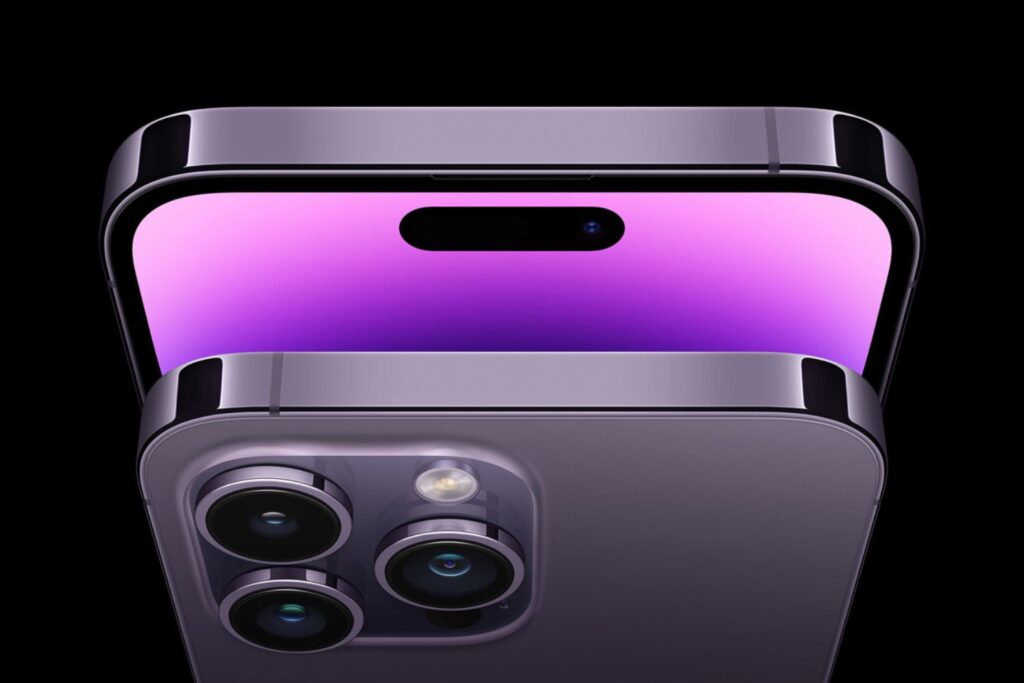[WATCH] Apple unveils iPhone 14 Pro and Pro Max with animated notches

Apple has unveiled its highly-anticipated iPhone 14 and iPhone 14 Plus smartphones, packing better performance, higher power efficiency, and the ability to communicate with satellites.
At its “Far Out” event on Wednesday, 7 September 2022, featured two sized of the devices a 6.1 inches and 6.7 inches — in a sophisticated design with impressive camera upgrades and new safety capabilities.
iPhone 14 and iPhone 14 Plus
Both models include the A15 Bionic chip with a 5-core GPU, which Apple said offers incredible performance and efficiency for demanding workloads, and is designed with privacy and security built in.
iPhone 14 and iPhone 14 Plus introduce critical safety capabilities such as Crash Detection and Emergency SOS via satellite, a first in the industry.
The devices introduce a new standard for photo and video capture with a new 12MP Main camera featuring a larger sensor and larger pixels, a new front TrueDepth camera, the Ultra-Wide camera to capture more of a scene, and Photonic Engine for a giant leap in low-light performance.
Through a deep integration of hardware and software, Photonic Engine improves mid- to low-light performance for photos across all cameras: up to 2x on the Ultra-Wide camera, 2x on the TrueDepth camera, and an impressive 2.5x on the new Main camera.
Photonic Engine enables this dramatic increase in quality by applying the computational benefits of Deep Fusion earlier in the imaging process to deliver extraordinary detail, and preserve subtle textures, provide better colour, and maintain more information in a photo.
The entire iPhone 14 lineup introduces safety capabilities that can provide emergency assistance when it matters most.
With a new dual-core accelerometer capable of detecting G-force measurements of up to 256Gs and a new high dynamic range gyroscope, Crash Detection on iPhone can now detect a severe car crash and automatically dial emergency services when a user is unconscious or unable to reach their iPhone.
These capabilities build on existing components, like the barometer, which can now detect cabin pressure changes, the GPS for additional input for speed changes, and the microphone, which can recognise loud noises typified by severe car crashes.

When a severe crash is detected, the emergency services call interface will appear on Apple Watch, as it is most likely to be in closer proximity to the user, while the call is placed through iPhone if it is in range for the best possible connection.
The iPhone 14 lineup also introduces Emergency SOS via satellite, which combines custom components deeply integrated with software to allow antennas to connect directly to a satellite, enabling messaging with emergency services when outside of cellular or Wi-Fi coverage.
This technology also allows users to manually share their location over satellite with Find My when there is no cellular or Wi-Fi connection, providing a sense of security when hiking or camping off the grid.
Emergency SOS via satellite will be available to users in the US and Canada in November, and the service will be free for two years.
iPhone 14 Pro and iPhone 14 Pro Max
Apple CEO Tim Cook calls the iPhone 14 Pro and Pro Max the “most innovative pro lineup yet”.
The first notable design change with the iPhone 14 Pro models is the display. While Apple will offer the usual 6.1- and 6.7-inch options, the notch is being replaced by a pill-shaped cutout that will house the Face ID components and a second circular cutout for the front-facing camera.
Apple said the A16 Bionic chip in iPhone 14 Pro and iPhone 14 Pro Max is generations ahead of the competition, and unlocks unparalleled experiences like the Dynamic Island, powers all-day battery life, and delivers impressive computational photography capabilities.
“With two high-performance cores and four high-efficiency cores, the new 6-core CPU is up to 40 percent faster than the competition and easily handles demanding workloads.”

A16 Bionic features an accelerated 5-core GPU with 50 percent more memory bandwidth — perfect for graphics-intensive games and apps — and a new 16-core Neural Engine capable of nearly 17 trillion operations per second.
Using Apple’s best-in-class fusion architecture to combine performance and energy savings, the chip delivers more performance with a fraction of the power compared to the competition.
Apple has moved the proximity sensor in both models behind the display, and notifications will now pop out of the notch in an animation.
Apple calls this system the Dynamic Island. Notifications and alerts will adapt and move around the pill-shaped notch, and Apple is really leaning into how it animates and uses the system for new notifications.
With the introduction of the Dynamic Island, the TrueDepth camera has been redesigned to take up less of the display area.
Without impeding content on the screen, the Dynamic Island maintains an active state to allow users easier access to controls with a simple tap-and-hold.
Ongoing background activities like Maps, Music, or a timer remain visible and interactive, and third-party apps in iOS 16 that provide information like sports scores and ride-sharing with Live Activities can take advantage of the Dynamic Island.
Apple demonstrated a variety of ways the Dynamic Island will animate and work in practice, including live activity widgets coming to life and animations and controls for music.
When you swipe to go home, background tasks like music playback will move to the island.
Both the iPhone 14 Pro and 14 Pro Max will include an always-on display that works with the new lock screen widget feature in iOS 16.
It will support information like reminders, calendar events, and weather without the iPhone having to wake up to display it.
There’s even a sleep state for iOS 16 wallpapers that will darken them to use less battery power.
Inside the iPhone 14 Pro models is Apple’s A16 Bionic chip. Apple has focused on power efficiency, display, and camera with its new chip.
The six-core CPU includes two high-performance cores that use 20 percent lower power and four efficiency cores that use a third of chips from competitors.
This new A16 chip helps power the smooth animations found in the Dynamic Island feature and will also power Apple’s new camera system.
For the first time ever, the iPhone is moving away from a 12-megapixel sensor to a 48-megapixel one.
The new main camera offers improvements to low-light photography, all using a quad-pixel sensor with f/1.78 aperture and 24mm focal length.
For most photos, the sensor will take 12-megapixel binned photos to maximize light capture. This also allows Apple to crop the sensor in different ways to deliver true 2x zoom at a 48mm focal length.
This should result in some impressive photos, and the new sensor even optimizes details in Apple’s ProRAW format.
The new ultrawide camera also offers improvements to macrophotography and a 3x improvement in low light. Apple has also upgraded the flash on the iPhone 14 camera system so it’s twice as bright and reacts to the focal length of photos.
The iPhone 14 Pro models can also now do 4K resolution at 30fps and 4K at 24fps.
Pricing and Availability
All four iPhone 14 models will be available for pre-order in the US from 9 September.
The iPhone 14, iPhone 14 Pro, and iPhone 14 Pro Max will start shipping on 16 September 2022, while the iPhone 14 Plus will be available from 7 October 2022.
The iPhone 14 and iPhone 14 Plus will start at $799 and $899 for the 128GB models.
The iPhone 14 Pro will carry a starting price tag of $999, while the iPhone 14 Pro Max will set buyers back no less than $1 099.





